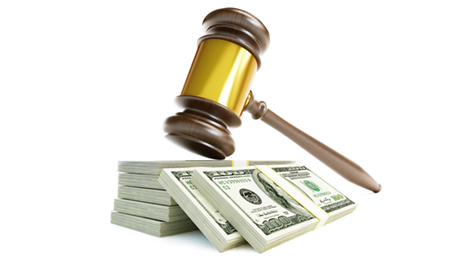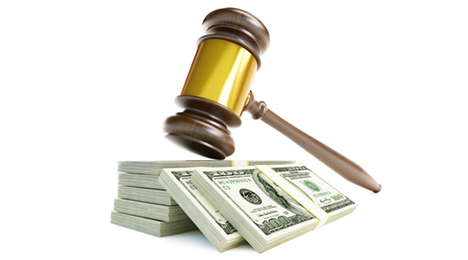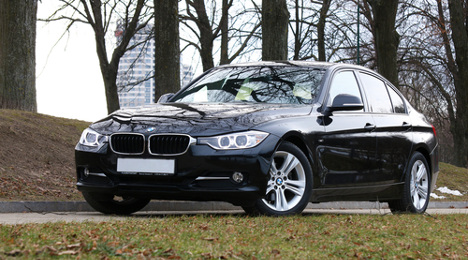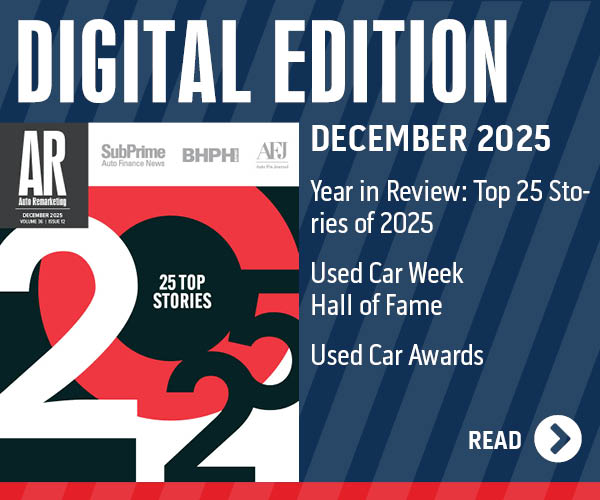As online bidding evidently intensified, Black Book also noticed the price strength of cars continued last week.
The latest Black Book Market Insights report showed that overall car values, when looking at volume-weighted data, appreciated slightly by 0.09 percent last week as opposed to the average weekly depreciation rate of 0.19 percent seen during the previous four weeks.
Among car segments, editors noticed the sporty car and sub-compact car segments performed the best, increasing by 0.50 percent and 0.36 percent, respectively.
Again based on volume-weighted data, Black Book reported that overall truck values were nearly flat last week. The average weekly depreciation rate for trucks had been 0.31 percent during the previous four weeks.
Within those truck segments, editors determined compact vans improved the most in value by 0.59 percent whereas compact luxury crossover/SUVs dropped the most in value by 0.20 percent.
“Market strength continued last week with most car segments showing an appreciation in values, led by sub-compact and sporty cars,” said Anil Goyal, senior vice president of automotive valuation and analytics at Black Book.
In terms of how dealers are acquiring inventory, a pair of Black Book sale attendees described how store managers leveraged online capabilities instead of just watching the lanes in person.
A Black Book representative in Illinois reported back, saying, “Smaller crowd in the lanes, but online bidding was brisk. Very few no-sales and prices were consistently strong.”
A similar scenario unfolded in Ohio as the lane watcher noted, “A lot of the bidding at this high-line sale was online. Increased interest in cars over trucks and SUVs had a lot to do with price.”
Moving further to the East, the report out of Massachusetts went this way: “A rep from a large dealer group stated the market was ‘on fire’ today. SUVs and trucks were the strongest.”
In the Sunshine State, Black Book discovered consignors enjoyed success at the Florida auction where Black Book stationed a representative who said, “OEM and bank-owned vehicles sold at high percentages but were almost all nice vehicles with acceptable miles considering the model years.”
And finally turning attention out West, Black Book’s auction attendee in Washington mentioned that the “auction owner reported on a sale where the sold percentage was 73 percent. This was an event sale but that percentage certainly supports a strong market.”
Black Book’s specialty report for April
As it does on a monthly basis, Black Book also examined the specialty segments for its latest Market Insights report. The rundown is as follows:
—Collectibles: Editors noted this year started off on a high note with the collectible car auctions in Florida and Arizona pulling in big numbers, and the five auctions held in conjunction with the Amelia Island Concours d’Elegance kept the momentum going with $121 million in sales.
—Recreational vehicles: With the exception of a few pockets of the country where the winter refuses to relax its grip, Black Book said it has started to see nicer weather and an active spring market.
—Powersports: Editors described the powersports market “is roaring ahead ‘full throttle’ this month with some of the largest increases in value they’ve seen in “quite some time.”
—Heavy duty: Black Book touched on this segment by stating, “The spring season brings us warmer weather, a fresh start for the New Year and used truck buyers refreshing their equipment if they are an end user, and restocking their inventory if they are a dealer.”
—Medium duty: Overall, editors pointed out medium duty trucks showed signs of strength in March, “which has been the norm for the past few years.”
The latest RVI Risk Outlook from RVI Group not only recapped February wholesale prices movements, but firm analysts projected where new-model lease penetration will trend through 2020 and how much of a pricing impact that level could make.
In the first-quarter report released on Tuesday, RVI Group indicated real used-vehicle prices (seasonally adjusted for 2- through 5-year-old units) continue to decline on a year-over-year basis. Analysts found that real used-vehicle prices (after adjusting for MSRP) fell by 6.4 percent in February when compared to the same month last year.
When compared to the previous month, RVI Group noticed real used-vehicle prices declined by 2.5 percent
In the small SUV segment, analysts pointed out prices fell by 5.9 percent on a year-over-year basis, performing better than the market average.
“The increasing supply of used vehicles and steady growth of incentive activity will continue to put downward pressure on used-car prices,” RVI Group said in the report that can be downloaded here.
RVI Group then projected that lease penetration will remain near “historical highs” through 2020.
“As the off-leased vehicles re-enter the market, we expect to see further declines in used-car prices,” analysts said. “Real used-vehicle prices are expected to decline 12.5 percent from current levels by 2020.”
Also in the report, RVI Group recapped that new-vehicle sales declined slightly in February to 17.5 million SAAR from 17.6 million in January. On a year-over-year basis, the report indicated vehicle sales declined by 0.8 percent in February.
Analysts mentioned the lease penetration rate for the fourth quarter of 2016 came in at 22.7 percent of total sales, a decline from 22.8 percent in the third quarter of the same year.
RVI Group went on to note that market level incentive activity has continued to grow, increasing to 10.0 percent of MSRP in February from 9.6 percent of MSRP in January. In February, analysts also highlighted the new vehicle CPI increased by 0.5 percent on a year-over-year basis but decreased by 0.2 percent on a month-over-month basis.
In recapping other trends collected by federal agencies, RVI Group highlighted that key economic indicators showed signs that the U.S. economy is steady.
In the fourth quarter of 2016, analysts said GDP grew at an annual rate of 1.9 percent, down from 3.5 percent growth in the third quarter.
“The slowdown was due to negative contributions from exports and federal government spending that offset positive contributions coming from personal consumption expenditure, private inventory investment, residential and nonresidential fixed investment, and state and local government investment,” RVI Group said.
In February, analysts recapped that the U.S. unemployment rate came in at 4.7 percent, a decline from 4.8 percent from the previous month, while the labor participation rate showed little change from January to February. Meanwhile, inflation came in at 2.7 percent, the highest inflation rate since March 2012, according to RVI Group’s report.
The demand for cars — especially units that could be retailed to potential buyers on the lower end of the credit spectrum — continued to be the topic in both the lanes and among Black Book editors last week.
The latest Black Book Market Insights report shows both car and truck segments retaining their values better than they have in the past six months. Editors highlighted car segments even increased their value as a whole by 0.21 percent as they said, “The lackluster performance of car segments seen in recent weeks was overcome by strong values last week."
Black Book noticed compact car and midsize car segments gained the most by 0.57 percent and 0.45 percent, respectively.
“This year promises to have a seasonal lift which was lacking last year,” editors added as the volume-weighted car market had declined on average by 0.38 percent in the previous four weeks.
On the truck side, looking at volume-weighted data, Black Book determined overall truck segment values (including pickups, SUVs and vans) decreased by 0.12 percent last week, lower than the depreciation rate of 0.40 percent spotted during the previous four weeks.
Editors said the sub-compact crossover segment declined the most by 0.89 percent, while compact van values increased by 0.37 percent.
“The typical spring market lift was evident last week with most vehicle segments performing well. Increased demand for compact and midsize cars drove values higher," said Anil Goyal, senior vice president of automotive valuation and analytics at Black Book.
What Goyal conveyed also was confirmed by Black Book’s representatives stationed at auctions nationwide. A large wholesaler and retail dealer from Kentucky told Black Book, “Full-size trucks have softened while compact vehicles have begun to hold their own.”
And next door in Tennessee, a scenario that’s unfolded multiple times this month surfaced again as Black Book’s lane watcher reported, “Not enough clean, older model vehicles at auction to keep up with the retail demand being driven mostly by tax refunds.”
Further south, the story continued as Black Book’s auction attendee in Georgia added, “The tax/spring market was evident today with vehicles selling often with strong values.”
Meanwhile on the opposite end of the East Coast, winter weather is still playing a role in the wholesale market, at least in Massachusetts.
“Low supply here this week led to strong prices. The negative effect on values that the snow storm would have created was off-set by the low supply,” Black Book’s representative said.
In Pennsylvania, the hammer didn’t exactly pound, especially in certain lanes. “Lots of activity in the dealer consignment lanes but the sales percentages weren’t great.”
Black Book also attended the grand opening of ADESA Chicago — which Auto Remarketing chronicled here. The Black Book observer added, “Great mix of vehicles and prices were strong.”
Finally, out West, Black Book’s watcher in Washington noted, “Prices are stable with a good selection of clean inventory. Sale percentages were up from last week.”
With one auction general manager describing the impact of tax refunds in the lanes, this week’s Black Book Market Insights report indicated the car segment retaining its value better than the truck segment as a whole.
However, editors pointed out that compact vans increased their value by 1.17 percent in the truck department, outperforming all other vehicle segments.
“The various car segments experienced broad market strength, particularly within compact, midsize and full-size models. Increased interest from dealers and higher sale percentages were noted in the auction lanes last week,” said Anil Goyal, Black Book’s senior vice president of automotive valuation and analytics.
Volume-weighted, the report said overall car segment values decreased by only 0.17 percent last week, lower than the depreciation rate of 0.46 percent reported during the previous four weeks.
The prestige luxury car and sub-compact car segments declined the most, sliding by 0.99 percent and 0.58 percent, respectively.
Again considering volume-weighted data, editors found that overall truck segment values including pickup, SUVs and vans decreased by 0.36 percent last week, similar to the depreciation rate of 0.37 percent spotted in the previous four weeks.
As mentioned, compact van values generated an increase of 1.17 percent, while the midsize luxury crossover/SUV segment posted the most decline at 0.77 percent.
Black Book’s representative caught up with an auction general manager in Pennsylvania after last week’s sale and reported this recap back to headquarters: “Great sale today. Tax money has caused percentages and values to be very high. Anything $7,000 or less with decent miles sells. Anything.”
Trucks also were in demand in other parts of the country as Black Book’s lane watcher in Illinois relayed, “Lots of snow on the cars coming through in Chicago today, but the prices were stable and especially good on full-size trucks.”
A similar scene unfolded in Tennessee as the observer reported, “Prices were up from last week with half ton pick-up trucks in demand.”
While not specifically mentioning tax refunds, Black Book’s representative in Ohio shared upbeat assessments, saying, “Activity was really good today on almost every consigned vehicle. Several dealers presented a very positive outlook for the spring market.”
Even further north, the positive vibe continued as the story coming out of Massachusetts was, “Prices exceptionally strong in Boston today. Sold percentages had the remarketers smiling.”
The only remotely negative anecdote passed back to Black Book originated in Texas where the observer said, “Watched a closed sale today and while they sold at a high percentage the values weren’t as strong as normal for a closed-sale environment.”
More confirmation about the unusual path wholesale prices took in February arrived from the team at KAR Auction Services on Tuesday.
Coming on the heels of what J.D. Power Valuation Services shared, ADESA Analytical Services’ monthly analysis of wholesale used vehicle prices by vehicle model class showed wholesale used vehicle prices in February averaged $10,688 — down 2.3 percent compared to January but up 4.8 percent relative to February of last year.
KAR Auction Services chief economist Tom Kontos explained that almost all model classes showed monthly declines. Kontos indicated in his monthly report, Kontos Kommentary, that although the slight increase to compact car prices was “encouraging,” this segment has been especially hard-hit by oversupply in recent years.
Kontos also noted the year-over-year growth in minivan prices is exaggerated by newer models as discussed last month.
“Further concrete evidence of price softening appeared in February as prices uncharacteristically, and unseasonably, softened rather than firmed versus January,” said Kontos, who elaborated about these trends in the online video available here and at the top of this page.
“Prices fell for virtually all model years and all model classes,” he continued. Prices were still up on a year-over-year basis, but this was again primarily due to the influx of younger off-lease units.”
Elsewhere in ADESA’s data, analysts found that average wholesale prices for used vehicles remarketed by manufacturers dipped 0.1 percent month-over-month and 1.0 percent year-over-year.
They also pointed out that prices for fleet/lease consignors dropped 3.4 percent sequentially but rose 3.6 percent annually.
“Within this segment, however, rental risk units showed month-on-month and year-on-year price declines,” Kontos said.
He went on to mention average prices for dealer consignors decreased by 1.2 percent versus January, but climbed 2.5 percent relative to last February.
Based on National Automobile Dealers Association data, Kontos closed by stating retail used-vehicle sales by franchised and independent dealers were down 3.8 percent month-over-month but jumped 6.5 percent year-over-year. As highlighted in Auto Remarketing, he also mentioned February certified pre-owned sales rose 9.8 percent month-over-month but came in flat year-over-year, according to figures from Autodata Corp.
ADESA Wholesale Used-Vehicle Price Trends
| |
Average |
Price |
($/Unit) |
Latest |
Month Versus |
| |
Feb. 2017 |
Jan. 2017 |
Feb. 2016 |
Prior Month |
Prior Year |
| |
|
|
|
|
|
| Total All Vehicles |
$10,688 |
$10,945 |
$10,202 |
-2.3% |
4.8% |
| |
|
|
|
|
|
| Total Cars |
$8,732 |
$8,867 |
$8,508 |
–1.5% |
2.6% |
| Compact Car |
$6,658 |
$6,639 |
$6,650 |
0.3% |
0.1% |
| Midsize Car |
$7,942 |
$8,044 |
$7,667 |
-1.3% |
3.6% |
| Full-size Car |
$8,092 |
$8,300 |
$7,378 |
-2.5% |
9.7% |
| Luxury Car |
$13,015 |
$13,472 |
$12,902 |
-3.4% |
0.9% |
| Sporty Car |
$13,478 |
$13,041 |
$12,901 |
3.3% |
4.5% |
| |
|
|
|
|
|
| Total Trucks |
$12,650 |
$12,990 |
$12,032 |
–2.7% |
5.1% |
| Minivan |
$9,004 |
$9,289 |
$7,262 |
-3.1% |
24.0% |
| Full-size Van |
$12,838 |
$12,430 |
$12,429 |
3.3% |
3.3% |
| Compact SUV/CUV |
$10,733 |
$10,762 |
$10,615 |
-0.3% |
1.1% |
| Midsize SUV/CUV |
$11,319 |
$11,854 |
$10,665 |
-4.5% |
6.1% |
| Full-size SUV/CUV |
$13,140 |
$13,715 |
$12,100 |
-4.2% |
8.6% |
| Luxury SUV/CUV |
$18,258 |
$18,697 |
$17,761 |
-2.3% |
2.8% |
| Compact Pickup |
$8,818 |
$8,954 |
$8,370 |
-1.5% |
5.4% |
| Full-size Pickup |
$15,796 |
$16,039 |
$15,303 |
-1.5% |
3.2% |
Source: ADESA Analytical Services.
Only twice since 1997 has the analyst team at J.D. Power Valuation Services seen February wholesale prices move this way.
According to the latest Guidelines report and in a reversal of what typically occurs in February, J.D. Power indicated wholesale prices of used vehicles up to 8 years old fell “substantially” last month, dropping 1.6 percent compared to January.
The report noted the decline was counter to the 1-percent increase expected for the month and marked just the second time in the past 20 years prices fell in February. The other instance came a year ago, and the dip was just a “scant” 0.2 percent.
NADA Used Car Guide’s seasonally adjusted used vehicle price index fell for the eighth straight month, declining 3.8 percent from January to 110.1. Analysts noticed the drop was by far the worst recorded for any month since November 2008 as the result of a recession-related 5.6 percent tumble.
Analysts also mentioned February’s index figure was 8 percent below the year-ago reading of 119.4, representing the index’s lowest level since September 2010.
“February’s outsized drop is likely due to a variety of factors,” analysts said via Guidelines. “Manufacturers dialed up incentive spending 18 percent last month to help reduce new vehicle inventory levels that are at a decade-plus high.
“In addition, late-model auction sales volume (vehicles up to 3 years old) continued to move higher, rising by 6 percent versus the four-week period ending Jan. 30,” they continued. “Finally, federal tax refunds — which historically support demand and thus pricing through a given first quarter — haven’t been distributed quickly compared to past years.”
As referenced by Cox Automotive chief economist Tom Webb as well, the delay stems from new laws requiring the Internal Revenue Service to withhold refunds claiming the Earned Income Tax Credit (EITC) and the Additional Child Tax Credit (ACTC) until mid-February, with the hold applying to the entire refund and not just the portion associated with the credits.
“The IRS cautioned EITC and ACTC filers that refunds wouldn’t start arriving in bank accounts until the week of Feb. 27,” J.D. Power said. “Checks would take longer to receive, of course.”
Per the IRS, the total number of refunds issued through Feb. 10 was nearly 52 percent lower than over the same period last year while the total amount distributed fell from $94 billion to $29 billion, a drop-off of 69 percent.
The situation was much better by the week of Feb. 24, however, as total refund numbers and amounts were still down by 11 percent and 10.5 percent, respectively.
“The sizable sum of disposable income sidelined in February logically played a role in pinching used vehicle demand over the month,” analysts said.
At the segment level, J.D. Power determined mainstream segment prices were “almost universally” softer than what is typical for February.
Dropping 2.1 percent, analysts said prices for the “ailing” subcompact car segment fell most among non-luxury vehicles, while large utility prices decreased 1.9 percent.
“While subcompact car price weakness is a running trend, it appears softer large utility prices are developing into one as well,” J.D. Power said via Guidelines. “Following several years of relative strength, the large utility segment has turned in subpar performances in five of the past seven months.”
Analysts also pointed out that compact and midsize utility prices were also “weak,” falling an average of 1.6 percent or about 1-percentage point worse than what occurred last year. Compact and midsize cars, two segments whose prices normally firm up most over the first quarter, experienced a 1.5-percent decline on average, according to the report.
As has been the case for numerous months, analysts found that midsize and large pickup prices slipped by roughly 0.5 percent last month, the least in the industry.
J.D. Power went on to mention luxury segment losses were bookended by the luxury large car segment’s 3.1-percent drop and the luxury midsize utility segment’s 0.9 percent decline.
“Overall, luxury segment losses were generally in line with what occurred during the month the past few years,” analysts said.
So what price trends could develop in March? J.D. Power closed its segment on pricing in the latest installment of Guidelines by looking ahead.
“February’s unusually soft showing makes pinpointing where used prices will go over the next few months a bit more challenging. However, given the slower than usual rollout of federal tax refunds, it’s assumed prices will be somewhat stronger in March and April than originally anticipated,” analysts said.
For March, J.D. Power predicted prices of vehicles up to 8 years in age should increase by approximately 2.5 percent and then decline by 1 percent in April. Expectations are roughly 1-percentage point better than last month’s forecast.
“Across segments, mainstream car prices should rise close to the industry average in March with mainstream truck and utility increases slightly less,” analysts added. “Luxury segment prices are expected to rise by an average of 1 percent to 1.5 percent over the month.”
Director of market intelligence Larry Dixon elaborated about these points further in the video available here and at the top of this page.
Used-car managers looking for luxury cars might be finding deals in the lanes, according to the latest Black Book Market Insights Report.
Black Book senior vice president of automotive valuation and analytics Anil Goyal said, “Luxury brand cars have shown higher drops in value on a percentage basis in the recent weeks in comparison to mainstream brand cars.”
The report indicated that volume-weighted, overall car segment values decreased by 0.31 percent last week, lower than the depreciation rate of 0.43 percent seen in the previous four weeks.
As mentioned, editors determined prestige luxury car and near luxury car segments declined the most by 0.94 percent and 0.57 percent, respectively.
Again volume-weighted, Black Book found that overall values in the truck segment (including pickups, SUVs and vans) decreased by 0.43 percent last week, higher than the depreciation rate of 0.36 percent noticed during the previous four weeks.
Editors spotted that the full-size luxury crossover/SUV and small pickup segments declined the most a week ago, softening by 0.80 percent and 0.63 percent, respectively.
Turning next to what Black Book representatives at auctions nationwide observed last week, activity might have been most intense on opposite ends of the country.
In California, the lane watcher relayed, “Lots of action here today with above normal amount of consignment and a normal amount of buyers.”
And in Florida, a similar scenario unfolded where Black Book personnel reported, “Awesome sale today with a very high sold percentage. As usual, sales did start dropping off towards the end.”
Elsewhere, the pace wasn’t quite as intense, as the observer in Georgia said, “Consignment and attendance both below normal here today with sales being moderate.” Next door in Tennessee, the story was “Rainy today but an overall positive market outlook with full size trucks leading in demand.”
Out West, the report coming out of Nevada indicated, “Midsize cars and all trucks sold well today with vans a little slower than last week.”
And finally, the Midwest recap indicated dealers might have a little extra work to do before getting the units front-line ready as the situation in Illinois was, “Consignment today had several that had previous paint work and some visible damage but still sold well overall.”
On Monday, Black Book announced another regular analysis offering covering the wholesale market — the Black Book Used Vehicle Retention Index — saying this product is designed to offer an “unbiased, accurate” view of the strength of today’s used wholesale market values.
Editors explained the Black Book Used Vehicle Retention Index is calculated using Black Book’s published wholesale average value on 2- to 6-year-old used vehicles as percent of original typically-equipped MSRP. Black Book’s wholesale average is a benchmark value for used vehicles selling in the wholesale auctions with the vehicle quality in average condition. The index is weighted based on used vehicle registration volume and adjusted for seasonality, vehicle age, mileage, condition, segment mix, and inflation (MSRP).
Aggregated from daily vehicle value updates, and captured throughout hundreds of wholesale physical and online auto auctions across the country, the company went on to note the Black Book Used Vehicle Retention Index is designed to represent data across all regions of the U.S. The index is based on a comprehensive list of vehicles included in the Black Book wholesale database, and includes no bias toward any brand, auction or region, ensuring a more accurate reporting of the used vehicle market.
The Index dates back to January 2005, three years prior to the beginning of the economic recession, where Black Book published a benchmark index value of 100.0 for the market. In March of this year, the index reading came in at 115.9, indicating a 16-percent increase in used vehicle retention strength since 2005.
That being said, editors pointed out the index has fallen steadily since October 2015, when the index registered a score of 127.0. This recent trend illustrates a continued, slow weakening of the used-vehicle market as a result of cresting demand and increased supply in the used market.
As more 2- to 6-year vehicles return to the market in the coming years, Black Book said this index can provide an overall measurement of strength/weakness in wholesale used vehicle value retention. During the recessionary period, the index experienced a sharp drop of about 14 percent from Jan. 2008 to Jan. 2009.
In 2010, the index recovered nicely and gained 10 percent during the year. After the recession, the index continued to rise persistently until 20111 and remained high till 2015. The index lost 6 percent in 2016.
Black Book added the index is expected to continue its slow decline in 2017 as the used-vehicle market loses strength.
When broken down by segments, the index shows some interesting trends, especially comparing two contrasting vehicle segments.
Compact car values have continued to decline sharply during the last two years due to the lack of consumer demand and higher supply for these vehicles.
On the other hand, full-size SUV index values are currently near all-time high.
“Automotive professionals today base critical, profit-dependent decisions on accurate, unbiased data that offers clear insight into the market,” said Anil Goyal, senior vice president of automotive valuation and analytics at Black Book. “The Black Book Used Vehicle Retention Index represents the industry’s guide into the strength of the market, with no bias.”
To obtain a copy of the latest Black Book Wholesale Value Index, go to this website.
Some new-car models, particularly a few luxury vehices, are resold after just one year of ownership signficantly more often than the average car is, according to a newly released analysis by iSeeCars.com
While just 1.5 percent of car buyers resell their new cars within the first year of ownership, iSeeCars spotlighted 11 models thatn see at least twice the rate of resale when compared to average car, says the research firm.
iSeeCars analyzed more than 24 million individual new car sales and counted how many of those new cars were reselling as used within the first year.
Six of the 11 models are from BMW and Mercedes-Benz.
The top three models include the BMW 3 Series, BMW 5 Series, and Mercedes-Benz C-Class
“All re-sold at rates that are quadruple the average of all models,” said iSeeCars.com
“This is partly attributed to dealers reselling their loaner vehicles which they have an oversupply of due to incentives from the automakers.”
The following is a list of the new cars resold most often as used within the first year of ownership, according to iSeeCars.com, along with percentage going this route.
BMW 3 Series, 8.0%
BMW 5 Series, 7.1%
Mercedes C-Class, 6.1%
Nissan Versa Note, 4.0%
Dodge Dart, 3.9%
BMW X3, 3.9%
BMW 4 Series, 3.9%
Mercedes E-Class, 3.9%
Chrysler 200, 3.8%
Subaru WRX, 3.3%
Nissan Versa, 3.2%
"While some might be surprised that these luxury brands top the list, these auto manufacturers offer their dealers incentives to buy new cars to use as loaner vehicles, which are then sold as used when they are still under a year old," Phong Ly, chief executive officer of iSeeCars.com said in a news release. "This is a marketing strategy with a two-fold purpose. It puts brand-new models in the hands of current owners when they bring their cars in for service, increasing the likelihood that they will buy another car from that brand. In addition, it essentially increases the brand's new car sales, which help to give them the ability to claim the title of 'top luxury brand', something that BMW and Mercedes-Benz compete for every year."
iSeeCars suggests that one reason these models are being resold within the first year of ownership is linked to quality or perceived quality of the cars.
Aside from the BMW and Mercedes-Benz models, the remaining models on the list, all ranked an average of three stars or less in the J.D. Power 2016 U.S. Initial Quality Study, which surveys consumers after 90 days of ownership, iSeeCars said.
"It's not surprising that consumers would make a change after a short amount of time if they felt the quality was lacking," Ly said. "After all, a new car is a very expensive purchase and one that consumers spend a significant amount of time with multiple times a day."
Additionally, the high resale rate of the 11 models represents an excellent opportunity to find bargains on them.
Nine of the 11 models have an estimated discount 12.7 percent higher than the average car, according to iSeeCars.com.
The following is a list of each model's average discount.
Chrysler 200: 29.9%
Dodge Dart: 27.4%
Nissan Versa Note:20.2%
Mercedes C-Class: 19.6%
Mercedes E-Class: 19.3%
BMW 5 Series: 18.2%
BMW 3 Series: 18.0%
BMW 4 Series: 17.3%
Nissan Versa: 14.1%
BMW X3: 12.7%
Subaru WRX: 6.2%
iSeeCars analyzed more than 24 million individual new car sales of model years 2015-2017 within calendar years 2015 and 2016.
The firm used each car's Vehicle Identification Number to see whether the car was re-listed between four months and a year of its sell date.
New cars with over 500 miles and used cars with less than 4000 miles were excluded from the study.
The amount of cars relisted as used was then articulated as a percentage of the number of new car sales by iSeeCars.com.
Along with releasing its latest weekly price movement update via the Black Book Market Insights report, the firm’s data also indicated the average price of a used vehicle for model years 2011 through 2015 depreciated by 0.8 percent in February.
Editors noticed cars overall produced depreciation of 0.8 percent versus trucks, which saw 0.7 percent depreciation. Black Book said all vehicles are averaging a 12-month depreciation change of 17.9 percent.
In February, editors noticed small pickups performed the best, increasing their value by 0.2 percent. Vehicles in the small pickups segment include the Toyota Tacoma, Chevrolet Colorado, Nissan Frontier and Honda Ridgeline. Their data showed vehicles in this category finished the last month with an average segment price of $19,138.
Black Book added that the small pickup segment also managed to retain its value compared to year-ago levels the best, only depreciating 7.1 percent from the 2016 value of $20,597.
Editors continued on to highlight that two segments saw a monthly depreciation of 1.8 percent in February, the highest depreciation for the month. Those segments include premium sporty cars and midsize luxury CUV/SUV.
Premium sporty cars finished the month of February with a value of $38,039, a 19.5-percent decrease from last year’s value of $47,239. Vehicles in this segment include the BMW 6-Series, Chevrolet Corvette, Jaguar F-Type and the Lexus RC350.
Midsize luxury CUV/SUVs ended last month with an average segment value of $21,479, a 20.1-percent drop from year-ago levels ($25,869). Vehicles in this segment include the Buick Enclave, Infiniti QX60, Land Rover LR4 and the Lincoln MKX.
Editors went on to note that prestige luxury cars had the steepest decline in value in comparison to a year ago. The segment, which ended February with an average value of $37,294, saw a 25.6-percent fall in price from its year-ago value ($50,115). Vehicles in the prestige luxury car category include the Mercedes-Benz S-Class, Lexus LS 460, Audi A8 and the Jaguar XJ.
“Vehicle retention values have held relatively strong for the second month in a row this year, except for some luxury segments,” said Anil Goyal, senior vice president of automotive valuation and analytics at Black Book.
“Consumer confidence scored above the expected rate for February, and this coupled with the tax rebate season could be having a positive influence on the retention of vehicle values since there are more sales of smaller vehicles taking place,” Goyal continued.
Weekly update
Meanwhile, the Black Book Market Insights report showed that vehicles in the sub-compact crossover, compact van, sub-compact car and full-size pickup segments retained their values best last week.
Out of all segments in both car and truck categories, editors determined prestige luxury cars showed the largest depreciation while compact vans had the strongest retention.
“Tax refund checks have begun to arrive, prompting increased interest in small cars. This has led to better retention in values and higher auction sale percentages for these vehicles,” Goyal said.
Looking at volume-weighted data, Black Book said overall car values decreased by 0.51 percent last week. This figure is higher than the average depreciation rate of 0.39 percent seen in the previous four weeks.
In car segments, editors noted prestige luxury car, luxury car and premium sporty car segments declined the most, dropping by 0.98 percent, 0.65 percent and 0.52 percent, respectively.
Again reviewing volume-weighted information, Black Book indicated overall truck values decreased by 0.31 percent last week. This reading is similar to the average depreciation rate of 0.33 percent spotted during the previous four weeks.
In truck segments, editors pointed out midsize luxury crossover/SUV and full-size luxury crossover/SUV segments declined the most, dropping by 0.56 percent and 0.55 percent, respectively.
Rounding off its latest update, Black Book also relayed the observations of its representatives stationed at auctions throughout the country. With tax-refund money evidently coming into possible buyers’ accounts, dealers responded.
From North Carolina, the story was, “very little online buying today but on-site dealers were busy. Units below $5,000 were selling quickly.” And on the opposite side of the nation in California, the scene was “good consignment here today with above normal amount of buyers.”
In between, the situation was mixed as in Tennessee lane action was, “good sale today. Smaller cars actually had a lot of attention with the number of buyers being above average.” At another sale in the Volunteer State, “lots of lookers here today with clean compact cars in demand.”
Down in Georgia, the action unfolded this way: “Nice sunny day here with a normal amount of consignment but a bit low on buyers.”
And finally up in Washington, Black Book’s lane watcher said, “Prices in this location still seem high on most pickups and SUVs.”












